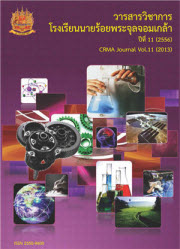Cause of Color in Metallic Wood Boring Beetle
Main Article Content
Abstract
The metallic wood boring beetle is in the Buprestidae Coleoptera, well known in the family of insects, consisted of about eight-thousand species. In Thailand, it can be found only two species. There are red legs“Sternocera ruficornis” and green legs“Ster-nocera aequisignata”. During the adult phase, they often show a variety color of wings such as orange, blue, green, and etc., More wings no hard and durable. It is classified as an organic gemology which is beautiful, valuable, and durable. Therefore many people keep it to made into jewelry and another objects. This study focuses on physical and chemical properties of the beetle wing by using the advanced scientific instruments. The optical microscope is used to study the surface and The scanning electron microscopy (SEM) is used to study in micrometer scale for characteristics of the wing surface. From the physical study, the variety of coloration is from specific characteristic of the wing surface of these beetles. The metallic line of the cuticle surface is another important fact, related to the light reflection process such as the diffraction grating. Therefore the wing surface reflects the light and causes interference in many directions then displaying an iridescent in many colors. The Fourier Transform Infrared Spectroscopy (FTIR) is used to study and compare the absorbance peak of the chemical compound in different colors of the beetle wing. The chemical property of the metallic wood boring beetle wing shows the organic compound of amide, O-H and Si-O groups. Otherwise the Si-O group causes the wing’s hardness and durability.
Article Details
Copyright of all articles published is owned by CRMA Journal.
References
วาลุลี และคณะ.แมลงทับอัญมณีที่กำลังจะหมดไป, ภาควิชา ชีววิทยาป่าไม้ คณะวนศาสตร์ มหาวิทยาลัยเกษตรศาสตร์ บางเขน.
N., Pinkaew, 2001, Some Biological Aspects of Sternocera ruficornis Saunder,1866 in Dry Dipterocarp Forest at Sakaerat Environmental.
Seraphin, S. Characterization Techniques for Nano- and Micro-Structural Analysis. University of Arizona.
R., Milton, 1997Spectrometric Identification of Organic Compounds. Published simultan-cously in Canada.
Pretsch, E., 2000. Structure Determination of Organic Compounds, Springer-Verlay Berlin Heidelberg.


